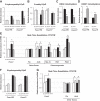Early-life physical activity reverses metabolic and Foxo1 epigenetic misregulation induced by gestational sleep disturbance
- PMID: 25568076
- PMCID: PMC4346758
- DOI: 10.1152/ajpregu.00426.2014
Early-life physical activity reverses metabolic and Foxo1 epigenetic misregulation induced by gestational sleep disturbance
Abstract
Sleep disorders are highly prevalent during late pregnancy and can impose adverse effects, such as preeclampsia and diabetes. However, the consequences of sleep fragmentation (SF) on offspring metabolism and epigenomic signatures are unclear. We report that physical activity during early life, but not later, reversed the increased body weight, altered glucose and lipid homeostasis, and increased visceral adipose tissue in offspring of mice subjected to gestational SF (SFo). The reversibility of this phenotype may reflect epigenetic mechanisms induced by SF during gestation. Accordingly, we found that the metabolic master switch Foxo1 was epigenetically misregulated in SFo livers in a temporally regulated fashion. Temporal Foxo1 analysis and its gluconeogenetic targets revealed that the epigenetic abnormalities of Foxo1 precede the metabolic syndrome phenotype. Importantly, regular physical activity early, but not later in life, reversed Foxo1 epigenetic misregulation and altered the metabolic phenotype in gestationally SF-exposed offspring. Thus, we have identified a restricted postnatal period during which lifestyle interventions may reverse the Foxo1 epigenetically mediated risk for metabolic dysfunction later in the life, as induced by gestational sleep disorders.
Keywords: Foxo1 gene; epigenetics; offspring metabolism effect; physical activity; pregnancy sleep disruption; reverse epigenetic effects.
Copyright © 2015 the American Physiological Society.
Figures












Similar articles
-
Late gestational intermittent hypoxia induces metabolic and epigenetic changes in male adult offspring mice.J Physiol. 2017 Apr 15;595(8):2551-2568. doi: 10.1113/JP273570. Epub 2017 Feb 22. J Physiol. 2017. PMID: 28090638 Free PMC article.
-
Sex dimorphism in late gestational sleep fragmentation and metabolic dysfunction in offspring mice.Sleep. 2015 Apr 1;38(4):545-57. doi: 10.5665/sleep.4568. Sleep. 2015. PMID: 25325475 Free PMC article.
-
Epigenomic profiling in visceral white adipose tissue of offspring of mice exposed to late gestational sleep fragmentation.Int J Obes (Lond). 2015 Jul;39(7):1135-42. doi: 10.1038/ijo.2015.38. Epub 2015 Mar 24. Int J Obes (Lond). 2015. PMID: 25801690 Free PMC article.
-
Offspring body size and metabolic profile - effects of lifestyle intervention in obese pregnant women.Dan Med J. 2014 Jul;61(7):B4893. Dan Med J. 2014. PMID: 25123127 Review.
-
Effects of sleep modulation during pregnancy in the mother and offspring: Evidences from preclinical research.J Sleep Res. 2021 Jun;30(3):e13135. doi: 10.1111/jsr.13135. Epub 2020 Jul 2. J Sleep Res. 2021. PMID: 32618040 Review.
Cited by
-
Obstructive Sleep Apnea Is Associated With Altered Glycemic Patterns in Pregnant Women With Obesity.J Clin Endocrinol Metab. 2019 Jul 1;104(7):2569-2579. doi: 10.1210/jc.2019-00159. J Clin Endocrinol Metab. 2019. PMID: 30794722 Free PMC article.
-
DNA Methylation in Pediatric Obstructive Sleep Apnea: An Overview of Preliminary Findings.Front Pediatr. 2018 May 29;6:154. doi: 10.3389/fped.2018.00154. eCollection 2018. Front Pediatr. 2018. PMID: 29896466 Free PMC article. Review.
-
The mediating effect of DNA methylation in the association between maternal sleep during pregnancy and offspring adiposity status: a prospective cohort study.Clin Epigenetics. 2022 May 20;14(1):66. doi: 10.1186/s13148-022-01284-w. Clin Epigenetics. 2022. PMID: 35596190 Free PMC article.
-
Sleep-disordered breathing in pregnancy: a developmental origin of offspring obesity?J Dev Orig Health Dis. 2021 Apr;12(2):237-249. doi: 10.1017/S2040174420000355. Epub 2020 May 19. J Dev Orig Health Dis. 2021. PMID: 32425147 Free PMC article. Review.
-
Late gestational intermittent hypoxia induces metabolic and epigenetic changes in male adult offspring mice.J Physiol. 2017 Apr 15;595(8):2551-2568. doi: 10.1113/JP273570. Epub 2017 Feb 22. J Physiol. 2017. PMID: 28090638 Free PMC article.
References
-
- Barres R, Yan J, Egan B, Treebak JT, Rasmussen M, Fritz T, Caidahl K, Krook A, O'Gorman DJ, Zierath JR. Acute exercise remodels promoter methylation in human skeletal muscle. Cell Metab 15: 405–411, 2012. - PubMed
-
- Bateson P, Barker D, Clutton-Brock T, Deb D, D'Udine B, Foley RA, Gluckman P, Godfrey K, Kirkwood T, Lahr MM, McNamara J, Metcalfe NB, Monaghan P, Spencer HG, Sultan SE. Developmental plasticity and human health. Nature 430: 419–421, 2004. - PubMed
Publication types
MeSH terms
Substances
Grants and funding
LinkOut - more resources
Full Text Sources
Other Literature Sources
Medical
Molecular Biology Databases
Research Materials
Miscellaneous

